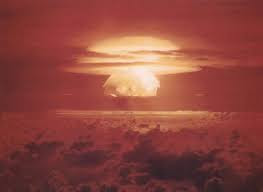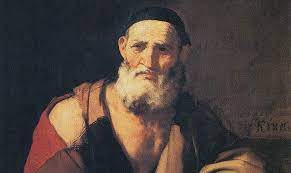 I watched on Netflix last night: Einstein and the Bomb. Rotten Tomatoes reviewers gave it an 83 rating. What surprised me was that while I knew it was his letter to President Franklin D. Roosevelt that got the U.S. going on the Manhattan Project, security reasons did not allow him to participate in the effort. The film Oppenheimer covers the building phase of the Atomic Bomb, and a portion of it shows Oppie meeting with Einstein.
I watched on Netflix last night: Einstein and the Bomb. Rotten Tomatoes reviewers gave it an 83 rating. What surprised me was that while I knew it was his letter to President Franklin D. Roosevelt that got the U.S. going on the Manhattan Project, security reasons did not allow him to participate in the effort. The film Oppenheimer covers the building phase of the Atomic Bomb, and a portion of it shows Oppie meeting with Einstein.So I thought this morning, what can go wrong today to instantly eliminate us. It then occurred to me that a nuclear war between Russia and the Free World would probably be it. One list has climate change at #1, nuclear warfare #2, pandemics #3, social media #4, The Butterfly Effect #5, quantum computing #6, AI #7, the death of all bees #8, asteroid impact #9 and alien invasion #10.
- But climate change will take time to kill us, and there are reasons to believe that we will gain control someday when decision-makers get truly serious.
- The war in Ukraine and the current NATO gathering in DC are happening now, and a threatened Vladimir Putin can end humanity in minutes.
- The Cold War between the Soviet Union and USA was the obvious beginning.
- But the suppositions and technology to cause this concern began long before.
Sure, the Manhattan Project, was a key step towards our potential imminent demise. This led to development of the Hydrogen Bomb, where the Soviet Union's Tsar Bomba's yield was 50 megatons, or ten times more powerful than all of the ordnance exploded during the whole of World War II, or 1570 times more powerful than the the combined potency of the Atomic Bombs dropped on Hiroshima and Nagasaki. Watch this previously secret footage of that H-Bomb explosion in 1961.
But what was the true beginning?
- Leucippus of Miletus around 430 BC originated the atomic philosophy. His disciple, Democritus of Abdera named the building block of matter atomos.
- Epicurus of Samos around 300 BC used Democritus's ideas to say that the entire universe was composed exclusively of atoms and void.
- Aristotle contributed to the Greek atomic theory a century later.
- Galileo in 1638 tested Aristotelian atomic theory.
- Anglo-Irish chemist Robert Boyle's law in 1663 helped develop the atomic theory, suggesting molecules.
- Around 1704, Isaac Newton said:
All these things being considered, it seems probable to me that God in the Beginning form’d Matter in solid, massy, hard, impenetrable, moveable Particles, of such Sizes and Figures, and with such other Properties, and in such Proportion to Space, as most conduced to the End for which he form’d them; and that these primitive Particles being Solids, are incomparably harder than any porous Bodies compounded of them; even so very hard, as never to wear or break in pieces; no ordinary Power being able to divide what God himself made one in the first Creation.
- German scientist Martin Klaproth in 1789 discovered uranium.
- Joseph-Louis Proust of France in 1794 combined chemicals, known as Proust's law.
- Between 1803 and 1808 English scientist John Dalton extended that law, and converted the Greek atomic philosophy into a scientific theory, introducing his law of multiple proportions.
- French chemist Louis Gay-Lussac in 1809 extended Dalton's atomic theory.
- Amedeo Avogadro in 1811 proposed also built on Dalton.
- German physicist Joseph van Fraunhofer between 1814 and 1824, studying the Sun, developed Fraunhofer Lines.
- A generation later, German scientist Gustav Kirchoff used spectral lines, and with German chemist Robert Bunsen discovered cesium and rubidium.
- During the 1860s Russian chemist Dmitry Mendeleyev used Avogadro's theory of diatomic molecules and in 1869 introduced the periodic law.
- Scottish scientist James Clerk Maxwell and Austrian Ludwig Boltzmann introduced sophisticated mathematics into physics.
- British scientist Michael Faraday electrolysis experiments added to the development.
- In 1881, English physicist J.J. Thomson discovered the electron.
- In 1885, Swiss secondary school teacher Johan Blamer published spectral lines for hydrogen, followed in 1890 by Swedish physicist Johannes Rydberg with his Rydberg constant, approaching what in the future resulted in Einstein's simple equation.
- In 1888, French mathematician Henri Poincaré had a theory that somehow mentioned both energy and mass, but did not make that connection.
- German physicist Wilhelm Röntgen discovered X-rays in 1895.
- French physicist Henri Becquerel discovered uranium in 1896.
- Pierre and Marie Curie discovered polonium and radium.
- In 1897, English physicist JJ Thompson found the electron.
- New Zealand/Great Britain physicist Ernest Rutherford in 1899 showed that radioactive substances emit more than one kind of radiation.
- German physicist Max Planck introduced his constant.
- Fritz Hasenöhrl, Austria's leading physicist, in 1904 wrote three prize-winning papers on the subject.
- Then, German scientist, Albert Einstein, who was reading what Hasenöhrl wrote, in 1905 postulated that energy equals mass times the speed of light, using Planck's Constant.
- Say you have a small amount of a material, like a penny. This tiny mass if converted to energy will provide electricity for New York City for two years.
- However, he was then a mere 27-year old patent clerk, and it took a full year for Einstein's equation to make an impact.
- American physicist Robert Millikan enhanced the work of Thomson in 1909
- English physicist Francis Aston further improved Thomson's technique by inventing the mass spectrograph in 1919. He discovered a variety of isotopes.
- In 1911 Ernest Rutherford described the structure of the atom. His postdoctoral student was Hans Geiger, who invented the Geiger Counter.
- Danish theoretical physicist Niels Bohr developed his quantum shell model of the atom in 1913, using Planck's Constant. (From the left, Bohn, Heisenberg and Pauli in 1936)
- Various scientists in Germany for the next decade took the lead in what would lead to the Atomic Bomb.
- In 1924, German physicist Werner Heisenberg provided the mathematics which Austrian Wolfgang Pauli in 1925, then only 25 years old, developed into his exclusion principle.
- In 1926, Austria Erwin Schrödinger developed his wave theory equation.
- In 1928, Paul Dirac introduced a new equation that was crucial in the making of an atomic bomb.
- That same year, Russian-born American physicist George Gamow (right) provided a clue to tunneling.
- In 1932, English physicist James Chadwick discovered the neutron.
- In the mid-thirties, Italian-born American physicist Enrico Fermi entered the picture.
- In 1938 German chemists Otto Hahn and Fritz Strassmann discovered NUCLEAR FISSION.
- The University of Chicago with Fermi, constructed a self-sustaining nuclear reactor in 1942.
In short, if you think that all it took was for Einstein to write to FDR, who then commissioned the Manhattan Project to produce Little Man and Big Boy over Japan....no, this all started with an early Greek atomic theory more than two millennia ago. A lot of scientists from a wide variety of nations through history to accomplish that task. What was amazing was the timing, for it all came together with Oppenheimer in World War II.
The prime motivation, which even Einstein admits, was that Germany, with all its scientists, was supposedly close to producing the Atomic Bomb for Hitler. For that reason, scientists had no serious problem with any fear factor about morality. Only after Hiroshima and Nagasaki did a swarm of scientists and politicians involved with building Atomic Bombs confirm their sincere original concerns about what they had wrought. But is it now too late? Saw Oppenheimer? Then you absolutely must watch Threads, an iconic disaster film that will frighten you. If you clicked on that, this is the entire 2-hour film. I urge you to do so. Rotten Tomatoes gave scores of 100/92. For a very good reason.
-


























Comments
Post a Comment